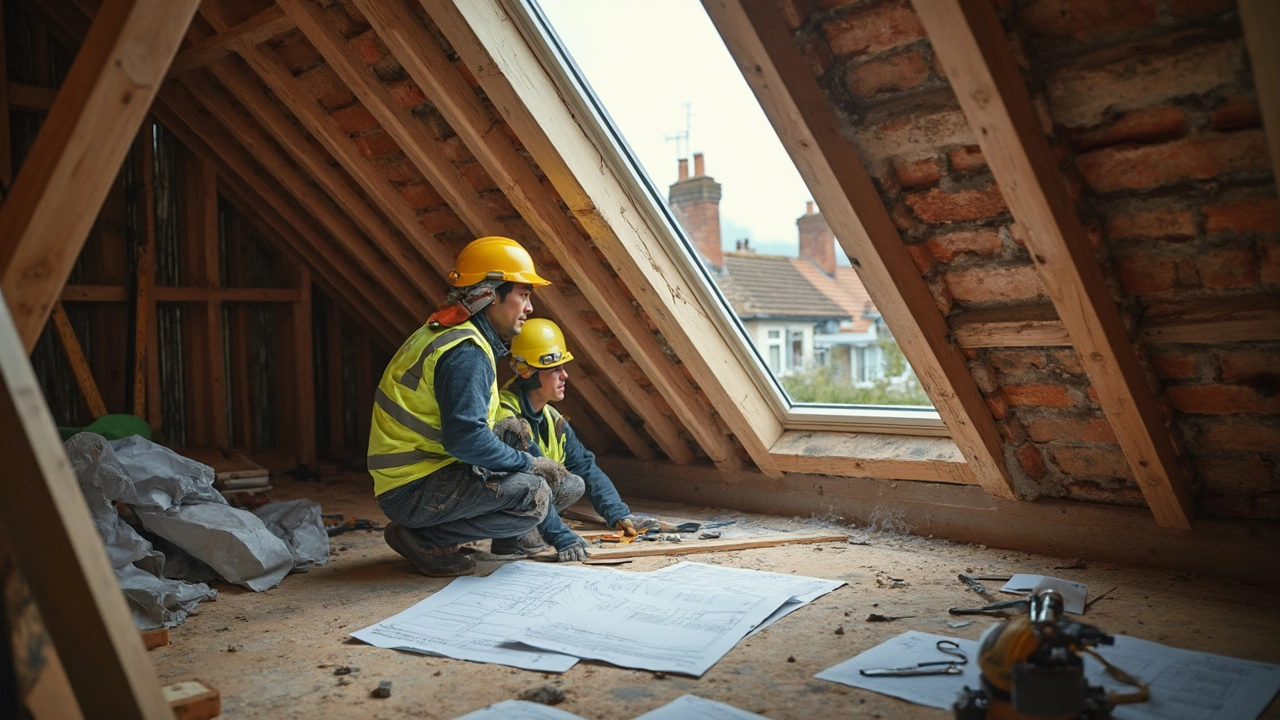People always ask, 'Why is a loft conversion so expensive?' The truth is, most of the cost isn’t about paint, carpet, or even the stairs. The big bucks usually go toward making the attic safe and strong enough to live in. Think beams, new joists, and support structures—this is the stuff that holds your entire project together. If your house can’t hold extra weight or if the roof is too low, those fixes will chew up your budget faster than you can blink.
This comes up most often with older houses. roofs that look fine from the outside can need pricey internal changes, especially if you want lots of headroom. It's not as simple as throwing up a few plasterboards. Sometimes, contractors have to take off half the roof or prop the whole thing up while they build a better one. And here’s a tip: even if your current attic looks empty, don’t assume the structure underneath is ready for everyday living.
- Why Structural Changes Dominate the Bill
- The True Cost of Roof Alterations
- Insulation, Windows, and Hidden Surprises
- Saving Money Without Cutting Corners
Why Structural Changes Dominate the Bill
When people budget for a loft conversion, they often focus on things like paint, fancy fixtures, or even the staircase. But the real wallet-buster is usually behind the walls and under the floors. Most loft spaces just aren't built to take the extra weight of people, furniture, and new rooms. That's why serious structural work almost always ends up as the biggest chunk of your bill.
One of the first things builders look at is the type of roof you’ve got. There are mainly two types in the UK: trussed roofs and traditional (cut) roofs. Trussed roofs, common in houses built after the 1970s, are tricky because their webs of timber hold your whole roof together but get in the way of new rooms. Making them liveable means swapping in big steel beams and stacking up loads of scaffolding. That’s not cheap. Traditional roofs offer more open space, but they often need strengthening too.
The floor is another money pit. Original attic joists usually aren’t designed for regular use. Builders have to beef them up with new timber or steel, which means tearing up floors and ceilings all over the house. Even before you think about walls or windows, all this grunt work can soak up over 50% of your build budget.
Check out this breakdown for an average three-bedroom UK home:
| Work Needed | Typical Cost Range (£) |
|---|---|
| Structural beams and supports | 7,500 – 12,000 |
| Replacing or strengthening joists | 3,000 – 6,000 |
| Roof alterations/raising | 6,000 – 18,000 |
If you run into hidden surprises (like weak foundations or hidden damp), costs can climb even more. Some cities have strict building codes which can mean extra reinforcements or even complete roof rebuilds. Planning for the worst helps avoid nasty surprises once the work gets going.
Before hiring anyone, get a specialist to check your structural needs. It costs money upfront but can save you loads later. Solid planning is your best friend if you don’t want to see your loft budget spiral out of control.
The True Cost of Roof Alterations
If you’re talking about what really ramps up the price on a loft conversion, roof work is high on the list. Most homes in the UK have traditional cut roofs or modern truss roofs. If your loft uses trusses, you’re looking at a bigger job—those W-shaped timbers are usually in the way and need replacing with steel beams and different joists. This kind of structural work adds thousands, sometimes pushing your costs up by 40-50% right out of the gate.
The main factors that affect roof alteration costs include:
- Type of roof structure: Truss roofs are much trickier and pricier to convert than older cut roofs with big open spaces.
- Raising the roof or altering pitch: If your ceiling is too low, contractors may have to lift the roof entirely. This alone can start at £15,000-£25,000, and that’s before you even finish the inside.
- Adding dormers: Dormer windows add headspace and light, and they're super popular. But even a simple rear dormer can add £7,500 to £15,000 to your bill. Hip-to-gable conversions or fancy L-shape dormers cost even more.
- Structural reinforcements: Often, steel beams need craning in (yep, literally over the house), which needs permits and specialist crews.
It’s not just the build. Local rules, scaffolding, and weather protection add to the bill. If your area is in a conservation zone or the house is listed, expect extra charges for approvals and slowdowns while waiting for sign-off.
Here’s a quick breakdown of real numbers from UK loft conversion projects:
| Alteration Type | Typical Cost (£) | Notes |
|---|---|---|
| Simple Roof Strengthening | 5,000 - 8,000 | Traditional cut roof only |
| Truss Roof Conversion | 8,000 - 20,000 | Requires beams, big changes |
| Add Dormer Window | 7,500 - 15,000 | Standard rear dormer |
| Full Roof Lift | 15,000 - 30,000 | Major work, only if needed |
If you want a tip, always get your roof assessed early by a chartered structural engineer. They can spot trouble before the builders find it, saving you cash and keeping your project on track. Don’t just trust online quotes—get in-person inspections, ask about the worst-case scenario, and always plan for a 10-15% contingency, since roofs love to hide surprises.

Insulation, Windows, and Hidden Surprises
Once you get past the main structure, insulation and windows are the next big things that can push your loft conversion price up. You can’t just throw regular insulation up there and call it a day. New building regs in the UK say your loft has to meet strict standards for heat loss, so you’ll be looking at high-performance insulation—think rigid foam boards or spray foam. Skimp here and you’ll not only freeze in winter or roast in summer, but probably fail your sign-off inspection. Quality insulation can cost anywhere from £30 to £50 per square metre depending on the type you go for.
Now, let’s talk windows. Most people want loads of natural light, so Velux windows or even bigger dormer windows are a must. But that’s not just a simple cut-and-fit job. Good roof windows need skilled fitting to make sure they’re watertight. Extras like blackout blinds or integrated vents sound small but add up. One Velux window, all-in with fitting, can easily hit £1,200 or more. Add a flush dormer, and the bill really starts climbing, especially if you want custom shapes or sizes.
Here’s where the "hidden surprises" kick in. The moment builders start ripping into the roof, stuff you never thought of shows up. Rotten timbers, old wasp nests, dodgy cabling, or even lack of fire breaks can all turn a straightforward job into something messier—and pricier. It’s not rare for a conversion to run £3,000 or more over original estimates because of these curveballs. If your house is older than forty years, budget at least 10% extra for the unexpected, seriously.
| Item | Average Cost (UK, 2025) |
|---|---|
| High-Performance Insulation (per m²) | £30 - £50 |
| Standard Roof Window (installed) | £1,200 |
| Flush Dormer Window | £5,000 - £7,000 |
| Unforeseen Repairs | +10%+ total cost |
The lesson here? When planning your loft conversion, don’t just look at headline quotes. Dig into specs for windows and insulation, and keep some money aside for whatever lurks behind your old ceiling plaster. You’ll thank yourself later.
Saving Money Without Cutting Corners
If you’re serious about a loft conversion but don’t want to empty your bank account, there are smart ways to save without causing problems later. The trick is being careful about what you cut back—and what you don’t. Skimping on things like structural work or insulation usually ends up more expensive down the line. Here’s how you can bring down the bill safely.
- Loft conversion design matters: Simple layouts cost less. If you can stick to the existing roof profile and avoid dormers, you could save thousands. Plus, ready-made staircase kits cost way less than custom stairs.
- Get multiple quotes: Don’t just go with the first builder on Google. Prices can swing by up to 25% depending on who you ask. Always get at least three written quotes, and make sure each covers the same spec.
- Buy materials in bulk: Contractors with trade accounts can get better prices on wood, insulation, or plasterboard. Ask them if you can use their discount, or see if bulk deals are possible.
- DIY what you can: Things like painting, decorating, or even fitting shelves are time-consuming but easy enough to do yourself. Just don’t mess with electrics or roofing unless you know what you’re doing.
- Pick the right time: Builders are busiest from spring to early autumn, which can add to costs. If you aren’t in a rush, ask about quieter periods when you might get a better deal.
Check out this comparison of typical costs in the UK to spot where you can save the most:
| Item | Low-End Estimate | High-End Estimate |
|---|---|---|
| Structural Works | £12,000 | £25,000 |
| Roof Alterations | £8,000 | £20,000 |
| Windows & Insulation | £2,500 | £7,000 |
| Stairs | £1,000 | £4,000 |
Remember, the best savings happen when you plan well and get clear, detailed quotes. Hidden extras show up when you rush into the project or leave things vague. And don’t forget, an energy-efficient loft pays you back over the years, so quality insulation might cost more now but cuts heating bills every winter.

Author
Damon Blackwood
I'm a seasoned consultant in the services industry, focusing primarily on project management and operational efficiency. I have a passion for writing about construction trends, exploring innovative techniques, and the impact of technology on traditional building practices. My work involves collaborating with construction firms to optimize their operations, ensuring they meet the industry's evolving demands. Through my writing, I aim to educate and inspire professionals in the construction field, sharing valuable insights and practical advice to enhance their projects.